|
“Oriental Greyhounds: I. Slughi, Tazi
or Gazelle hound, or Slughi Shami… II. Ahk-Taz-eet or Kirghiz Greyhound…
III. The North African Slughi, or Slughi of the Sahara... IV. The Barukhzy
Hound, or Afghan Greyhound… V. The Rampur Hound, or Greyhound of Northern
India… VI. The Poligar hound, or Greyhound of Southern India…
It should be the object of all those who import
the Greyhounds of the East, and breed them in this country, to try to keep
distinct the different varieties, which in many cases have been so carefully
preserved in their own lands. The historic interest attached to each breed
is alone a sufficient inducement to do so.”
Amherst F.(1907, Oriental Greyhounds in Cassell’s
New Book of the dog, ed. R.Leighton Ch.LVI, London)
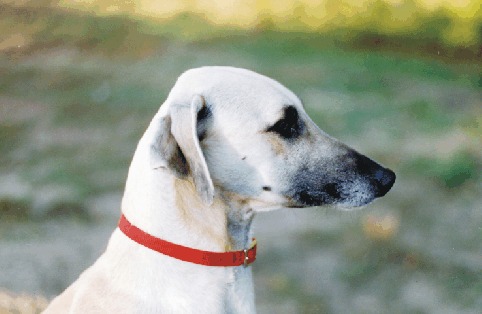
Sloughi
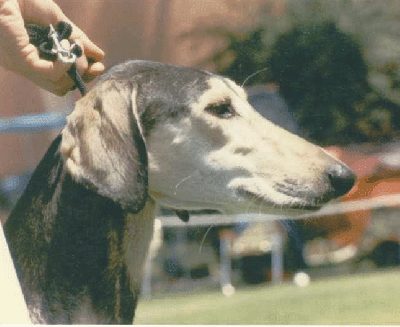 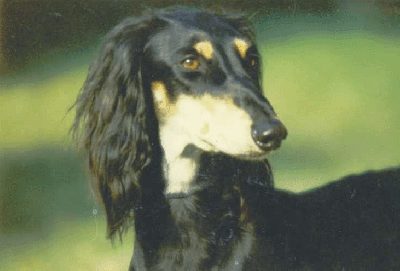
Smooth Saluki
~ Feathered Saluki
Ever since sighthounds,
greyhounds or Sloughis/Salukis were imported from their countries of origin
in Asia and Africa into the western world, numerous myths about their origin
have abounded. Clearly, except for the Greyhound and some smooth-coated
dogs around the Mediterranean Sea, no other dog of the 420 or so known
breeds (of which the AKC recognizes less than half) resembles these hounds.
Their swiftness and stamina, their elegant build and their noble attitude
all contribute to the fascination these breeds have generated among the
dog fanciers in the western world.
History shows sighthound-like dogs depicted in
ancient images in the countries of origin that resemble in many ways sighthounds
still living there today. Consequently, some fanciers assume that indeed
Salukis are ancient and may have arisen some 2,000 or more years ago and
may be the oldest breed of domesticated dogs. The images found in Egypt
and Tepe Gawra suggest that such smooth and coated sighthounds might be
even older and date back to the earliest civilizations known to modern
man.
Be
this as it may, the checkered history of many countries in North Africa
and Southeast Asia raises certain doubts about the undisturbed continuity
of the breeding of these hounds across such long expanses of time. In addition,
the vast geographic area over which these sighthounds are spread, combined
with limited accessibility in certain remote areas, raise issues of geographic
isolation and limited genetic exchange which eventually could alter the
genetic composition of various local populations. Nevertheless, based on
certain features, in many cases not shared with more distantly related
breeds, it seems reasonable to group all these hounds of the Orient and
North Africa into a single group with other comparatively built dogs: the
lop-eared sighthounds of many national and international dog registries
of today (Afghan Hound, Azawakh, Saluki, Sloughi)
Among
the various sighthounds found throughout Africa and the Middle East, none
has stirred more passion than the Sloughi/Saluki/Saluqi group of hounds.
In part, the debate revolves around the name, which describes in Arabic
the local sighthound or windhound. Since in a given area only one of those
hound types typically exists, there was no need to have more than the generic
name that was equally used to describe the specific local variety. Of course,
this linguistic confusion of generic and specific, combined with various
transliterations of Arabic into European languages and the fact that both
the colloquial “Sloughi” and the classical “Saluki” may be used to some
extent interchangeably, have confused this matter even more. This confusion
is well summarized in Waters’ book on the Saluki ("The Saluki in History,
Art and Sport," by Hope and David Waters, David & Charles, 1969), and
the reader is referred to this book for more detail.
In the modern era, the Sloughi of North Africa
(henceforth simply referred to here as Sloughi) was first imported from
the French North African colonies to France in the 1800s. These dogs were
well known in France since 1850 through the books of General Daumas and
also featured at international dog shows. Holland also was a major home
of the Sloughi, brought back at the end of the 19th century from Africa
by Auguste Le Gras. Feathered sighthounds were portrayed on the European
continent earlier than 1700, and were sporadically seen in the UK in the
18th century. It was around the turn of the 20th century that serious breeding
started, following the first imports of “Slughi Shami”to England by Lady
Florence Amherst (as she then named them) , and later on the feathered
sighthounds of Brigadier Lance. These dogs provided the ancestors of the
modern Saluki in the West.
After
the First World War ended and with the demise of the Ottoman Empire, both
the French and the British had access to the Middle East and brought back
many Salukis (named thus in England since 1923). Surprisingly, it appeared
that the Saluki came in two varieties, a feathered variety and a smooth
variety. Logically, having a sighthound from the Middle East that
had features in common with the smooth Sloughi of North Africa and the
smooth sighthound-like dogs painted on the murals of ancient Egypt raised
a number of questions about the relatedness of these dogs.
Different opinions developed about this subject
over the past century and are summarized as follows:
1) Sloughis of North Africa and Salukis both belong
to the group of oriental lop-eared sighthounds but are not more closely
related to each other than the Saluki is with his eastern sighthound relatives,
the Afghan Hound or the Tazi and Taigan of the steppe. The arguments in
favor of this scenario assume the geographic isolation of the Sloughi in
the vast expanse of Northern Africa and rely on the morphological differences,
now also reflected to some extent in written standards of the breeds. It
assumes that the Sloughi and Saluki evolved in their respective countries
of origin and should be kept distinct. We will refer to this idea as the
“Sloughi hypothesis”
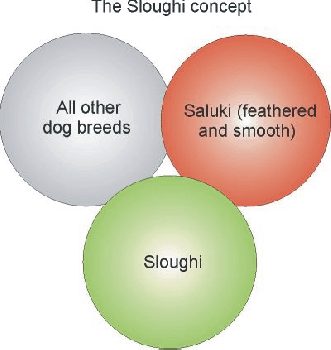
Fig. 1. The Sloughi and Saluki
today form distinct breeds, with some potential overlap of both breeds
with each other and with other dog breeds.
2) In contrast to this idea is the assumption
that the different geographic varieties are tightly interconnected through
interbreeding and all Southwest Asian and African sighthounds form a single
large “breed”. The underlying assumption here is that western breeds known
as Afghan, Saluki and Sloughi are artifacts of the small extracted gene
pool used to found those varieties now registered as distinct breeds in
the West, and do not reflect the situation in the countries of origin which
show continuity in both phenotype and the underlying genotype. We will
refer to this hypothesis as the “Saluqi hypothesis.”
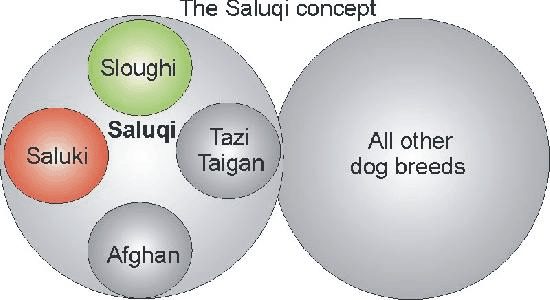
Fig. 2. The Sloughi/Saluki/Tazi/Afghan/Taigan
of today are varieties of one breed, the Saluqi, with little overlap with
other dog breeds.
3) A variation of this latter idea is the assumption
that among Oriental and African hounds three varieties are particularly
related to each other: the smooth and feathered Salukis of the Middle East
and the smooth-coated Sloughis and Azawakhs of Africa. This idea assumes
that the African Sloughi and Azawakh were derived from the Saluki following
the Arab invasion of North Africa in the 7th century. We will refer
to this hypothesis as the “Saluki hypothesis.”
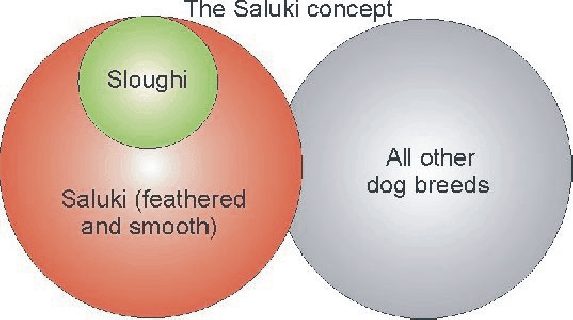
Fig. 3. The Sloughi is a
variety of the Saluki with some potential overlap with other breeds.
Numerous
arguments have been raised over the years by proponents and opponents of
each of these three hypotheses. With the recent completion of a large analysis
of the mitochondrial DNA of 654 dogs of some 124 known breeds, as well
as other indigenous dog and wolf populations, the implications of these
opinions can for the first time be tested. The samples processed included
8 Sloughis, 15 Salukis, 6 Taigans, 1 Tazi, 10 Basenjis, and 5 Afghan Hounds.
The
test consisted of sequencing an approximately 582-base-pair stretch (*
SEE FOOTNOTE) of mitochondrial DNA. This genetic material is only inherited
through the female lines, as male sperms lose their mitochondria upon entering
the female egg. In other words, such a study provides insights exclusively
into the female background of a given population, no matter what the male
looked like and what his genetic material was. Analyzing the male genetic
background of a population requires sequencing of the male-specific y-chromosome
that is only inherited from male to male without contribution from the
female. Such an analysis is on its way, but data are not yet available
(P. Savolainen, personal communication).
We used the mitochondrial DNA data provided by
Dr. Savolainen and looked at how they fit with the three ideas outlined
above. We wanted to know:
1) Are Sloughis and Salukis genetically distinct
or not? Genetic distinctness would support the Sloughi hypothesis
(Fig. 1), genetic similarity the Saluqi (Fig. 2) or Saluki hypothesis (Fig.
3).
2) Do Sloughi and Saluki share genetic material
with other breeds that co-exist in the same geographical area and potentially
crossed with them in the distant past? Are these two breeds embedded
genetically into their geographical origin while maintaining their unique
looks. Logically, the more genetic material is shared between these
breeds and nearby totally different looking breeds, the less likely it
is that consistent selective breeding took place over centuries.
3) Are there distinct genes in Salukis and Sloughis
not shared by other breeds? If the majority or all of the genetic
sequences in a given breed are unique, it would indicate a long history
of breeding from distinct females and would support the hypothesis that
Sloughis and Salukis are distinct breeds.
The Sloughi:
The
six sequences found in the eight Sloughis are 50% unique to the Sloughi
and not shared by any other breeds analyzed thus far (A4, A10, A33; 2 animals,
2 animals and 1 animal respectively). Of the three sequences shared
with other breeds, one is shared with another African breed, the Basenji
(A5, 1 animal) but also with three breeds from Japan, Tibet and Siberia.
Another sequence is shared with eight other breeds (A22, 1 animal):
Boxer, English Setter, Irish Wolfhound, Nguni and Sica (Africa), Scottish
Deerhound, Saint Bernhard, and Tibetan Terrier. The last sequence
(B1, 1 animal) belongs to a different sequence group and is the only one
shared with the Saluki, but also with 23 other known breeds, as well as
a large group of dogs from China and Indonesia. Among the breeds
are the Dachshund, Doberman Pinscher, Finnish Spitz, Pekingese, Golden
Retriever, Samoyed and Shiba (Fig. 4). These sequences are provided
by Sloughis that maternally originated, recently or in the past, in North
Africa, and of which some represent several well established European and
American lines.
Dr.
Savolainen and colleagues calculated that a single base substitution *(foot
note) reflects a mutation rate of about 26,000+-8,000 years. The
three unique sequences found in Sloughis are one or more substitutions
removed from other breeds. This suggests that the descendants of these
three lines may have stayed in North Africa for several thousand years.
This suggestion is supported by the sequences shared with the Basenji,
the Nguni and the Sica, African breeds that are now found only south of
the Saharan desert. At the same time the geographical range of the
other breeds who share this sequence (A5) suggests that it might be very
old and thus widespread across Eurasia and Africa. The two other shared
sequences suggest different things. The A 22 sequence could be related
to the invasion of North Africa by Germanic tribes in 5th-6th century or
could simply reflect the fairly widespread distribution across Europe,
Africa and Asia of this sequence and might not be related to any specific
historic event. The B1 sequence shared with the Saluki does not necessarily
reflect the invasion of North Africa by the Arabs and their hounds in the
7th century, but could be related to events long lost in the past, as it
is shared with other widely distributed breeds of dogs. Unfortunately this
study cannot tell us the following: was the maternal line a Sloughi or
were the mitochondria contributed by the other breeds, perhaps now extinct?
Nor can we know the timing of these events.
These results strongly support the idea of geographic isolation with some
incorporation of three widely dispersed female sequences for the Sloughi.
The unique sequences strongly support the notion that the Sloughi is a
genetically unique population of sighthounds and the sequences shared with
the Basenji, Sica and Nguni indicate that this breed is, on the maternal
side, embedded in Africa, possibly for thousands of years.
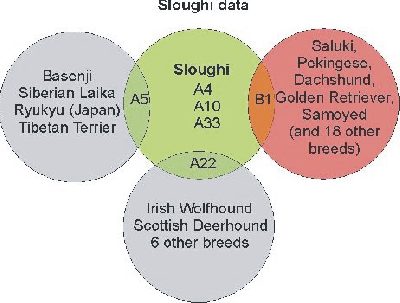
The Saluki:
The
eight sequences found in the 16 Salukis are 25% unique to the Saluki and
not shared by other breeds analyzed thus far (A43, B15, 1 animal each).
Six sequences are shared with other breeds (Fig. 5). For example, A9 (1
animal) is shared only with the Basenji, A26 (2 animals) only with the
Wirehaired Fox Terrier of Britain, and A15 (1 animal) is shared with the
Korean Jindo and Akbash from Turkey. The three sequences shared with
numerous other breeds constitute about 37.5 %. B2 (7 animals), is
shared with the Afghan, the Akbash, the Canaan Dog, the Taigan and the
Tazi from Kazakstan. B1 (2 animals) is the only one shared with the Sloughi,
but it is also shared with 23 other known breeds as well as a large number
of dogs from China and Indonesia. A11 (1 animal) is shared with over 35
breeds (Akbash, Akita, Basset Griffon, Borzoi, Canaan Dog, Chow-Chow, Fox
Terrier, Siberian Husky, Jindo, Kangai, Pekingese, Rottweiler, Taigan,
Thai Ridgeback, Whippet, and several dogs from China). All sequences were
derived from Salukis out of the Middle East or bred in Europe and America.
These results show that the genetic background of the Saluki is one of
the most complex of all breeds in this study. Clearly, the Saluki
is not a distinct population derived from a single “Saluki-Eve”. Local
Middle Eastern breeds such as Akbash and Canaan Dog appear several times
among the Saluki’s related breeds. Whether this is because of incorporation
of Saluki-like dogs into these breeds or vice versa remains unclear. The
Saluki shares sequences also with the Afghan, the Taigan, the Tazi and
the Borzoi. Since these sequences are also shared by other, non-sighthound
breeds, it is difficult to understand the direction of breeding:
a sighthound female crossed with those other breeds or a female of those
other breeds crossed with a sighthound male. If such crosses happened,
they may have been several thousand years ago, as the timeline of these
events can not be resolved with this study. The Afghan and Taigan share
a sequence unique to both, suggesting some, possibly ancient, relationship,
in addition to sequences shared with several other breeds.
This study indicates that the Saluki is a local Middle Eastern breed which
has been expanded genetically by incorporation of three minor and three
major maternal lines shared with few or with many other breeds. A
single sequence is shared with the Sloughi, but is also shared with 23
other breeds and a large group of indigenous dogs from China and Indonesia.
. Therefore, this single shared sequence does not prove an affinity
of maternal lines specific to the Sloughi. This contrasts with the more
profoundly shared maternal lines of the modern-day Saluki with local Middle
Eastern dogs such as Akbash and Canaan Dogs, but also other Eastern sighthounds.
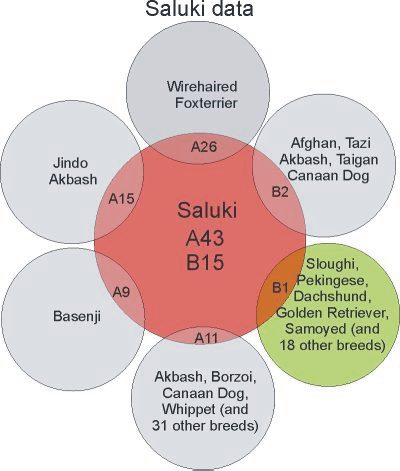
 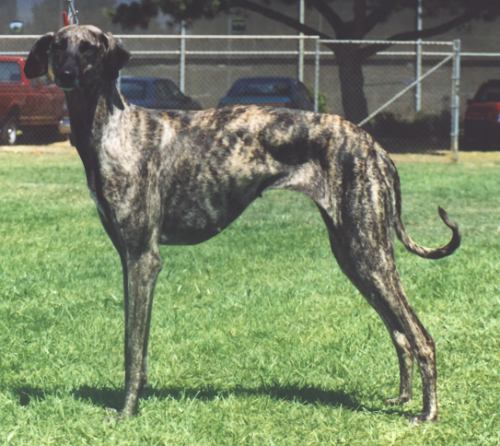
Saluki ~
Sloughi
The Saluki and Sloughi compared.
These
results reveal that the Sloughi breed is not integrated in the Saluki’s
gene pool, therefore cannot be derived from the Middle Eastern Hounds brought
by the Arabs when they invaded North Africa some 1300 years ago. If
this happened, it was of such a minor scale that it had virtually no impact
on the maternal lines of the Sloughis of this study. In fact, the
three distinct maternal lines of the Sloughi suggest that those maternal
lines might have been geographically isolated in Africa for several thousand
years. If combined with the shared sequence with the Basenji and other
African breeds, up to 67% of the female population of the Sloughi might
have been in North Africa for a very long time.
The
results for the Saluki indicate that the breed derives up to 62.5% from
possibly local females, which, however, may be common to other local dogs
such as Akbash and Canaan Dog. The number of sequences shared by
Saluki and Akbash is larger than those shared with any of the geographically
nearby sighthounds, including the Sloughi. These results do not support
the idea that the Saluki of today has been “purebred” over the last several
thousand years and thus might be the oldest purebred dog breed, except
if we assume that such integration happened long ago. The fact that
non-sighthound breeds such as Akbash and Canaan dog share more maternal
lines with Salukis than Salukis share with other sighthounds does not provide
support for the Saluqi hypothesis.
To conclude, these results support the idea that
the Sloughi and Saluki of today are distinct breeds with genetic ties to
each other that are no more profound than those of either to many other
breeds.
We hope that this essay will provide for a more rational basis of future
discussions. We deliberately refrained from quoting sources for the
various ideas in order to allow everyone the opportunity to reconsider
those ideas in the light of these genetic results. It needs to be
stressed, however, that these conclusions are based on a limited sample
size and might undergo some revision once more samples are included.
Nevertheless, the genetic data presented here for the first time support
the notion previously espoused by F. Amherst and others that these sighthound
breeds are distinct. We propose that these breeds should remain as separate
breeds until full resolution of their genetic background is completed.
A more complete resolution of all the questions raised here will have to
wait until the paternal side is known through analysis of the male Y chromosome.
Finally, correlating the genetic differences described here to differences
in phenotype will only be possible after the dog genome * (footnote) is
completed and the relationship of various genes to phenotype have been
clarified, research that will require many more years.
Acknowledgments
We thank Dr. P. Savolainen for improving an earlier
version of this manuscript.
References:
Amherst F. 1907. Oriental Greyhounds. In Cassell's
New Book of the Dog, ed. R Leighton, pp. Ch LVI. London: Cassell &
Co
Savolainen P, Zhang YP, Luo J, Lundeberg J, Leitner
T. 2002. Genetic evidence for an East Asian origin of domestic dogs. Science
298: 1610-3
Waters H, Waters D. 1969. The Saluki in History,
Art and Sport. Newton Abbot: David & Charles. 112 pp.
Footnote mtDNA stretch
All
genetic information is built of DNA (Deoxyribonucleic acid), a giant double
helical molecule that consists of four distinct units, called bases, arranged
in two parallel strands. These bases are A, T, C, G (Adenine, Thymine,
Cytosine, Guanine) A interacts with T, C interacts with G.
These interactions form bridges that hold the double stranded DNA together
in a full mirror complement of each other. In essence, the DNA is a biological
digital storage system that has four signals (the four bases) to code for
proteins.
The genetic information (DNA) of all mammals
is stored predominantly in the nucleus of each cell. In addition,
a small fraction of DNA is also found in mitochondria, the power plants
of each cell. This mitochondrial DNA (mtDNA) is only inherited from
the female to her offspring. No male mtDNA contributes to the next
generation. Therefore each male is a dead end with respect to inheritance
of mtDNA information. Analyzing the sequence of mtDNA provides thus
exclusive information only about the mother’s side of a given dog.
Only information about the mother, grandmother, great grandmother etc of
a dog will be revealed. Since mtDNA, like any other DNA, encodes
information in the arrangement of the four bases, one can compare the arrangements
of these four bases to study similarities of animals that result from common
inheritance. Thus, sequencing a stretch or segment of the mtDNA will
provide genetic information about the inherited relatedness of dogs.
Such an analysis would be comparable to ordering all of the letters on
this page into a single line without any interruptions and comparing this
with files similarly obtained of pages from other books. Logically,
only faithful copies of the page would show a high resemblance in the sequence
of letters over such a long stretch.
Base substitution.
Altering
the information encoded in the orderly arrangement of bases on the DNA
requires altering the sequence of bases. Such an alteration is called
a mutation. Such mutations can do a number of things. In many
cases, mutations change a single base. Thus, instead of an A it will
substitute that for a G, for example. Such base alteration rates
typically range in the order of several hundreds or thousands of years,
depending on the sequence in question.
Dog genome.
The genome
is all the inherited information or DNA carried from one generation to
the next in a given being. The genome of four mammals has thus far
been sequenced, humans, mice, rats and dogs. A comparison revealed
that dogs and humans share approximately 90% of their genes.
|







